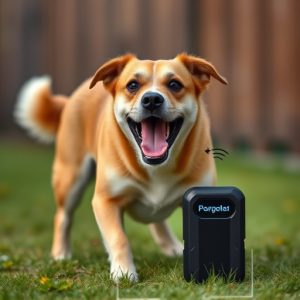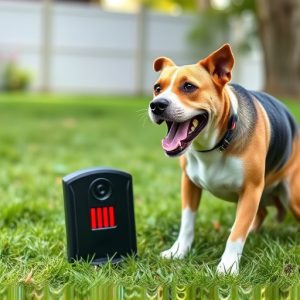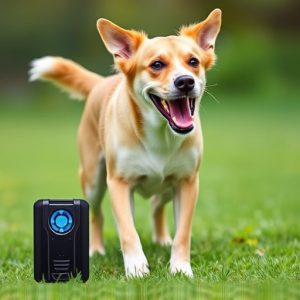FDA Approved Dog Repellents: Science-Backed Solutions for Effective Control
Dogs communicate via scent and sound, marking territory and warning others. For swift, safe interven…….
Dogs communicate via scent and sound, marking territory and warning others. For swift, safe interventions where conventional training fails, FDA-approved dog repellent devices disrupt canine communication channels using specific frequencies and sounds, encouraging them to stay away from unwanted areas without harm or stress. These advanced tools come in ultrasonic and non-ultrasonic options, catering to diverse needs; the best choice depends on personal preference, breed sensitivity, and application area. Key factors in selection include adjustable frequency settings, humane and safe repellency, size, portability, range, and user-friendly features like rechargeable batteries.
“Unwelcome visitors can disrupt your peace and harm your property, especially if you live in areas prone to dog intrusions. This is where FDA-approved dog repellent devices step in as a practical solution. Understanding canine behavior and the science behind these repellents is key to effective use. This article explores why these devices are necessary, delves into their working mechanisms, and identifies the optimal frequency ranges for maximum repulsion. We’ll also compare ultrasonic vs. non-ultrasonic models and guide you through choosing the best FDA-approved dog repellent.”
- Understanding Dog Behavior and Why Repellents Are Necessary
- The Science Behind FDA Approved Dog Repellent Devices
- Identifying the Effective Frequency Range for Dog Repulsion
- Types of Dog Repeller Devices: Ultrasonic vs. Non-Ultrasonic
- Factors to Consider When Choosing an FDA Approved Dog Repellent
Understanding Dog Behavior and Why Repellents Are Necessary
Dogs, like any other animals, have their own unique behaviors and communication methods. Understanding these is crucial when it comes to addressing issues like unwanted dog interactions. Dogs primarily use scent and sound to communicate, marking their territory and warning others through various vocalizations. Repellents step in as a necessary tool when conventional training methods fail or for situations requiring swift intervention.
In the market, there are numerous devices that claim to repel dogs, but it’s important to choose wisely. FDA-approved dog repellent devices offer a safe and effective solution without causing harm or stress to the animals. These products utilize specific frequencies and sounds that disrupt a dog’s communication channels, driving them away from unwanted areas without physical punishment or discomfort.
The Science Behind FDA Approved Dog Repellent Devices
The Science Behind FDA Approved Dog Repellent Devices
FDA Approved Dog Repellent Devices leverage a deep understanding of canine behavior and advanced technology to create effective solutions for managing unwanted dog activities. These devices operate on the principle of emitting specific sound frequencies that are unpleasant or distracting to dogs, thereby encouraging them to stay away from treated areas. The use of ultrasound, for instance, is a common method where high-frequency sounds above human hearing range are emitted, targeting the dog’s auditory system. This approach ensures safety for both pets and humans while offering a humane alternative to traditional repellents.
The effectiveness of these devices lies in their ability to disrupt dogs’ communication and perception without causing harm. The frequencies are designed to mimic natural deterrents like predator calls or unpleasant experiences, triggering an instinctive response to avoid the area. Moreover, continuous monitoring and adjustments ensure that the devices adapt to different environmental conditions and dog behaviors, maintaining their efficiency over time. This scientific approach has led to the approval of various FDA-approved dog repellent devices, offering pet owners a reliable and safe tool for managing canine behavior.
Identifying the Effective Frequency Range for Dog Repulsion
Identifying the effective frequency range for dog repulsion is a key step in choosing the right FDA-approved dog repellent device. Dogs, like humans, have sensitive hearing, but their range of audibility extends beyond human perception. Most dogs can detect sounds up to 40 kHz, while some breeds with particularly keen senses may hear even higher frequencies. Repeller devices that target specific frequencies within this range, often between 20-40 kHz, have been shown to be effective in deterring dogs without causing them harm.
These high-frequency sounds, though inaudible to humans, can activate a dog’s startle response, encouraging them to leave the area. It’s important to note that not all devices claiming to be FDA-approved for dog repulsion are created equal, so consumers should research and choose products from reputable manufacturers that have undergone thorough testing to ensure safety and effectiveness.
Types of Dog Repeller Devices: Ultrasonic vs. Non-Ultrasonic
Dog repeller devices have evolved significantly, offering a range of options for both pet owners and those seeking to keep their spaces free from unwanted canine visitors. One of the key distinctions lies in the technology employed: ultrasonic versus non-ultrasonic. FDA-approved dog repellent devices are particularly sought after due to their safety and effectiveness.
Ultrasonic repellers emit high-frequency sound waves that are inaudible to humans but can deter dogs. These devices are non-harmful and work by creating an unpleasant sensation for dogs, prompting them to leave the area. On the other hand, non-ultrasonic repellents use scent or visual cues, such as motion-activated sprinklers or sprayers, to discourage dogs. While effective, these methods may not be suitable for all environments or dog breeds. Choosing between ultrasonic and non-ultrasonic devices depends on personal preference, the target breed’s sensitivity, and the specific needs of the space being protected.
Factors to Consider When Choosing an FDA Approved Dog Repellent
When choosing an FDA-Approved Dog Repellent Device, several key factors come into play. First and foremost, consider the specific frequency range that the device offers. Different dogs have varying sensitivity to ultrasonic or pulse frequencies, so selecting a product with adjustable settings can ensure its effectiveness for your furry companion. Additionally, check if the repellent is humane and safe for both pets and humans, as approved devices prioritize animal welfare.
Size, portability, and ease of use are also important considerations. If you’re dealing with a large outdoor area, a device with a good range and powerful output will be more suitable. For smaller spaces or indoor use, lighter, compact models might suffice. Moreover, look for user-friendly features like rechargeable batteries, long-lasting operation, and convenient controls to make the repelling process hassle-free.
When selecting an FDA-approved dog repellent device, understanding the science behind it and choosing the right frequency range are key. By considering both the behavior of dogs and the latest technological advancements, you can effectively manage unwanted canine intrusions while ensuring safety for your family and pets. Opting for reputable brands that prioritize research and user needs will lead to successful results in creating a comfortable living space for all. Thus, armed with knowledge, you can choose among various options, including ultrasonic and non-ultrasonic devices, tailored to your specific requirements.


